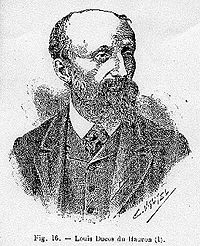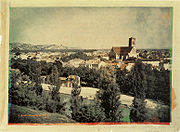
Louis Ducos du Hauron
Encyclopedia

France
The French Republic , The French Republic , The French Republic , (commonly known as France , is a unitary semi-presidential republic in Western Europe with several overseas territories and islands located on other continents and in the Indian, Pacific, and Atlantic oceans. Metropolitan France...
pioneer of color photography
Color photography
Color photography is photography that uses media capable of representing colors, which are traditionally produced chemically during the photographic processing phase...
. He was born in Langon
Langon, Gironde
Langon is a commune in the Gironde department in Aquitaine in southwestern France.-Geography:Langon is in the southern part of the department southeast of Bordeaux on the left bank of the Garonne river...
, Gironde
Gironde
For the Revolutionary party, see Girondists.Gironde is a common name for the Gironde estuary, where the mouths of the Garonne and Dordogne rivers merge, and for a department in the Aquitaine region situated in southwest France.-History:...
and died in Agen
Agen
Agen is a commune in the Lot-et-Garonne department in Aquitaine in south-western France. It lies on the river Garonne southeast of Bordeaux. It is the capital of the department.-Economy:The town has a higher level of unemployment than the national average...
.
After writing an unpublished paper setting forth his basic concepts in 1862, he worked on developing practical processes for color photography on the three-color principle, using both additive
Additive color
An additive color model involves light emitted directly from a source or illuminant of some sort. The additive reproduction process usually uses red, green and blue light to produce the other colors. Combining one of these additive primary colors with another in equal amounts produces the...
and subtractive
Subtractive color
A subtractive color model explains the mixing of paints, dyes, inks, and natural colorants to create a full range of colors, each caused by subtracting some wavelengths of light and reflecting the others...
methods. In 1868 he patented his ideas and in 1869 he published them in Les Couleurs en Photographie. The most widely reproduced of his surviving color photographs is the View of Agen, an 1877 image of a landscape in southern France, printed by the subtractive assembly method
Carbon print
A carbon print is a photographic print with an image consisting of pigmented gelatin, rather than of silver or other metallic particles suspended in a uniform layer of gelatin, as in typical black-and-white prints, or of chromogenic dyes, as in typical photographic color prints.In the original...
he pioneered. Several different photographs of the view from his attic window, one dated 1874, also survive, as do later views taken in Algeria, still life subjects, reproductions of paintings and art prints, and at least two portraits of uncertain date.
In 1891, he invented the anaglyph
Anaglyph image
Anaglyph images are used to provide a stereoscopic 3D effect, when viewed with glasses where the two lenses are different colors, such as red and cyan. Images are made up of two color layers, superimposed, but offset with respect to each other to produce a depth effect...
stereoscopic
Stereoscopy
Stereoscopy refers to a technique for creating or enhancing the illusion of depth in an image by presenting two offset images separately to the left and right eye of the viewer. Both of these 2-D offset images are then combined in the brain to give the perception of 3-D depth...
print, the "red and blue glasses" type of 3-D print. Although others had earlier applied the same principle to drawings or used it to project images onto a screen, he was the first to reproduce stereoscopic photographs in the convenient form of anaglyph prints on paper.


